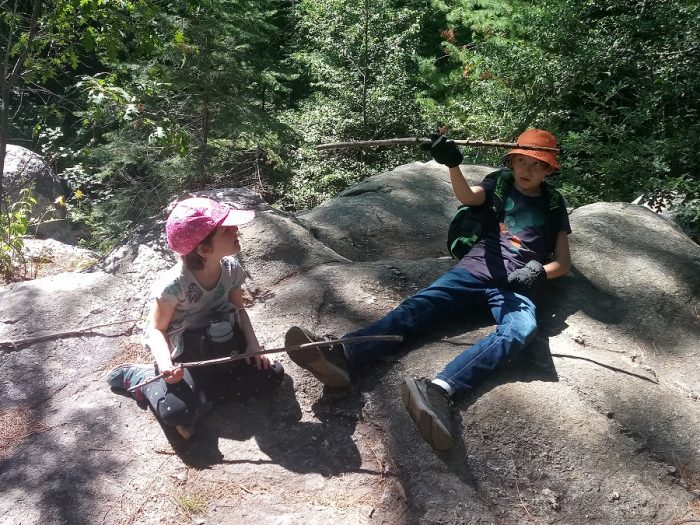Just outside the back door, rocks are tumbling in a cylinder filled with water and fine grit.
They’ve been tumbling for almost a week now. The sound is akin to a heavy rainstorm, and on a couple of occasions, I forgot about the noisy machine and peaked outside expecting rain and finding only the dry desert heat.
The rock tumbler is an exercise for my family and me in deferred gratification—one of many.
Deferred gratification is something that my partner excels at more than most people I’ve met, and being with him has shifted the way I experience my world. Our connection has started me on a path of being a lot more intentional and less reactionary. So when he asked me how I wanted to spend our time together on the weekends I have my kids, I took time to think about it.
Our time together is limited; it is finite. What would be the best way not only to connect as a family, (with my partner as a relatively new addition) but also to instill values in my children that will serve them foundationally for the rest of their lives?
We decided to go hiking. For my partner, my 11-year-old, and myself, this was an easy choice. We love being outdoors, are very active, and we love nature! For my five-year-old, however, this proved to be a challenge. She is much happier indoors, drawing and painting in a temperature-controlled environment with plentiful access to snacks, poufy pink dress-up clothes, her favorite toys, and other creature comforts.
When she grows up, she wants to be a dentist, a tattoo artist, and a baker—or just “The Queen.” On our first hike, she whined the whole way there, and even more on the way back. I remember feeling particularly dismal on the drive back home; my dream of the “ideal” family hike was clearly born out of naivete and too many Laura Ingalls novels.
Fortunately, I’d recently listened to James Clear’s Atomic Habits on audiobook, and I’d learned that for something to become a habit you need to keep doing it (that part seems obvious enough!), but also you need to find ways to make it accessible and enjoyable. So I began to pore through internet blog posts to see what the magical equation was to get my little Queen of Comfort to enjoy the outdoors with us. I also brainstormed a list of what her primary motivators are (sweet treats and art).
Then I came up with a strategy for the next hike: at certain checkpoints (“just at the top of that hill!” or “just to that fallen log over there!”) I would give her a “magic energy seed” (aka those tiny fruit candies in a small tin from Trader Joe’s). I was also going to draw her focus to the beauty of nature and cater to her inner artistic drive by pointing out flowers, butterflies, and colorful birds.
The “magic energy seeds” worked wonders. Suddenly, her legs that had been so tired on the first hike magically had more energy to make it to the next point along the trail. She was tickled by the beauty of a butterfly resting on a flower and wanted to take selfies with it. I felt hopeful! But then not far into our morning sojourn, she tripped on a tree root and scraped her knee and refused to go on after that. Again, I felt defeated and wondered if we should just wait until she is older.
But I thought back to what it is that encourages life-long habits. When I was a child, I was encouraged to pursue the things I thought I had a natural knack for, and I largely avoided the things that seemed too hard. This led me to give up on a great many things after only trying them a few times: ballet, piano, botany, anything involving tools, and jewelry-making.
Somewhere along the way, I realized that it is not talent that takes us to the places we want to go—it is practice. It is consistency. It is habit. This painfully earned knowledge is the one thing I hope to pass onto my children above all else, but it involves something that children (and most adults, if we are to be completely and painfully honest with ourselves) lack: a tolerance for deferred gratification.
So I recommitted. I found her better, more supportive hiking shoes. I showed her how to be mindful of her balance on rocky trails, and how to navigate uneven terrain. She continued to trip and fall, and each time I asked her how she felt and then asked her what she learned from the fall. She started to say things like, “I learned to go more slowly down the hills” or, “I learned to watch out for rocks.”
With each hike, we got a little further up the trail, until finally one day we made it up to the top. I heard something new in her voice then: pride for making it all the way. We talked about the progress that she had made, and she decided that she likes hiking—even though it’s hard.
My partner contributed a lot to this process as well, including increasing his patience (he is the kind of hiker who will—with his powerful long legs—make short work of any trail, without stops, as I fumble along like a hobbit falling farther and farther behind him). He also had the idea to start collecting a couple of small rocks on our hikes, and to start saving up for a rock tumbler. He even made a spreadsheet to show the kids how much we were all putting toward the rock tumbler over time; we all agreed to set aside 30 percent of chore money until we had enough. My 11-year-old was dubious about contributing some of his chore money to this, but reluctantly agreed. It took us months to get enough money together, but meanwhile, we kept going on hikes and kept adding to our modest collection of rocks.
Finally, we’d earned enough and we ordered the machine.
Then we had to wait for it to arrive.
Then we had to wait for the rocks to tumble.
Then the first machine broke before it had even run for a full 24 hours, so we had to wait for a replacement part.
By this point, even I was getting impatient!
At last, the rocks had been tumbling for a full week, and my partner poured off the gritty water to reveal a pile of smooth, vivid-hued stones. My children oohhd and aahhd over them, picking them up one by one for closer examination and running their fingers over the smooth surfaces. How much they had changed—little by little, day by day—until they were transformed simply by movement and friction with teeny, tiny particles.
My son turned to me and said that he was glad we’d saved our money for so long, and that it was all worth it. I’ve done some things I am proud of in my life—big attention-drawing things like writing my master’s thesis and finishing grad school—but I think that is the proudest I have ever felt.
Deferred gratification and habit-building come with this deeper knowing that I (along with my whole family) am on the right trail, and this feels a lot better than anything else we could do right this moment to stave off boredom and feel a wave of enjoyment and instant success.
~











Read 0 comments and reply